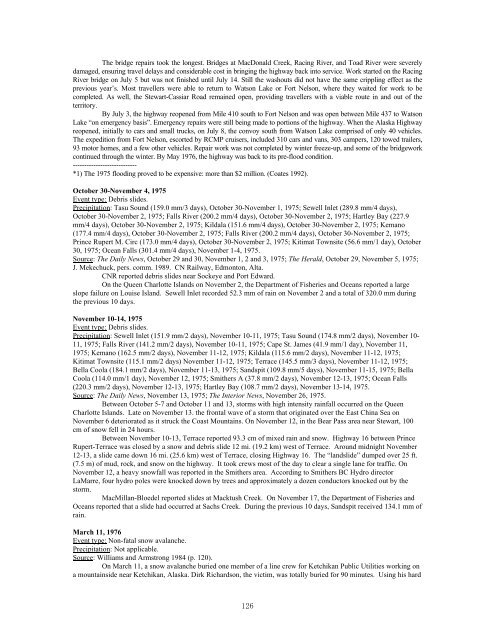HISTORICAL NEWS SEARCH - Government of British Columbia
HISTORICAL NEWS SEARCH - Government of British Columbia
HISTORICAL NEWS SEARCH - Government of British Columbia
Create successful ePaper yourself
Turn your PDF publications into a flip-book with our unique Google optimized e-Paper software.
The bridge repairs took the longest. Bridges at MacDonald Creek, Racing River, and Toad River were severely<br />
damaged, ensuring travel delays and considerable cost in bringing the highway back into service. Work started on the Racing<br />
River bridge on July 5 but was not finished until July 14. Still the washouts did not have the same crippling effect as the<br />
previous year’s. Most travellers were able to return to Watson Lake or Fort Nelson, where they waited for work to be<br />
completed. As well, the Stewart-Cassiar Road remained open, providing travellers with a viable route in and out <strong>of</strong> the<br />
territory.<br />
By July 3, the highway reopened from Mile 410 south to Fort Nelson and was open between Mile 437 to Watson<br />
Lake “on emergency basis”. Emergency repairs were still being made to portions <strong>of</strong> the highway. When the Alaska Highway<br />
reopened, initially to cars and small trucks, on July 8, the convoy south from Watson Lake comprised <strong>of</strong> only 40 vehicles.<br />
The expedition from Fort Nelson, escorted by RCMP cruisers, included 310 cars and vans, 303 campers, 120 towed trailers,<br />
93 motor homes, and a few other vehicles. Repair work was not completed by winter freeze-up, and some <strong>of</strong> the bridgework<br />
continued through the winter. By May 1976, the highway was back to its pre-flood condition.<br />
----------------------------<br />
*1) The 1975 flooding proved to be expensive: more than $2 million. (Coates 1992).<br />
October 30-November 4, 1975<br />
Event type: Debris slides.<br />
Precipitation: Tasu Sound (159.0 mm/3 days), October 30-November 1, 1975; Sewell Inlet (289.8 mm/4 days),<br />
October 30-November 2, 1975; Falls River (200.2 mm/4 days), October 30-November 2, 1975; Hartley Bay (227.9<br />
mm/4 days), October 30-November 2, 1975; Kildala (151.6 mm/4 days), October 30-November 2, 1975; Kemano<br />
(177.4 mm/4 days), October 30-November 2, 1975; Falls River (200.2 mm/4 days), October 30-November 2, 1975;<br />
Prince Rupert M. Circ (173.0 mm/4 days), October 30-November 2, 1975; Kitimat Townsite (56.6 mm/1 day), October<br />
30, 1975; Ocean Falls (301.4 mm/4 days), November 1-4, 1975.<br />
Source: The Daily News, October 29 and 30, November 1, 2 and 3, 1975; The Herald, October 29, November 5, 1975;<br />
J. Mekechuck, pers. comm. 1989. CN Railway, Edmonton, Alta.<br />
CNR reported debris slides near Sockeye and Port Edward.<br />
On the Queen Charlotte Islands on November 2, the Department <strong>of</strong> Fisheries and Oceans reported a large<br />
slope failure on Louise Island. Sewell Inlet recorded 52.3 mm <strong>of</strong> rain on November 2 and a total <strong>of</strong> 320.0 mm during<br />
the previous 10 days.<br />
November 10-14, 1975<br />
Event type: Debris slides.<br />
Precipitation: Sewell Inlet (151.9 mm/2 days), November 10-11, 1975; Tasu Sound (174.8 mm/2 days), November 10-<br />
11, 1975; Falls River (141.2 mm/2 days), November 10-11, 1975; Cape St. James (41.9 mm/1 day), November 11,<br />
1975; Kemano (162.5 mm/2 days), November 11-12, 1975; Kildala (115.6 mm/2 days), November 11-12, 1975;<br />
Kitimat Townsite (115.1 mm/2 days) November 11-12, 1975; Terrace (145.5 mm/3 days), November 11-12, 1975;<br />
Bella Coola (184.1 mm/2 days), November 11-13, 1975; Sandspit (109.8 mm/5 days), November 11-15, 1975; Bella<br />
Coola (114.0 mm/1 day), November 12, 1975; Smithers A (37.8 mm/2 days), November 12-13, 1975; Ocean Falls<br />
(220.3 mm/2 days), November 12-13, 1975; Hartley Bay (108.7 mm/2 days), November 13-14, 1975.<br />
Source: The Daily News, November 13, 1975; The Interior News, November 26, 1975.<br />
Between October 5-7 and October 11 and 13, storms with high intensity rainfall occurred on the Queen<br />
Charlotte Islands. Late on November 13. the frontal wave <strong>of</strong> a storm that originated over the East China Sea on<br />
November 6 deteriorated as it struck the Coast Mountains. On November 12, in the Bear Pass area near Stewart, 100<br />
cm <strong>of</strong> snow fell in 24 hours.<br />
Between November 10-13, Terrace reported 93.3 cm <strong>of</strong> mixed rain and snow. Highway 16 between Prince<br />
Rupert-Terrace was closed by a snow and debris slide 12 mi. (19.2 km) west <strong>of</strong> Terrace. Around midnight November<br />
12-13, a slide came down 16 mi. (25.6 km) west <strong>of</strong> Terrace, closing Highway 16. The “landslide” dumped over 25 ft.<br />
(7.5 m) <strong>of</strong> mud, rock, and snow on the highway. It took crews most <strong>of</strong> the day to clear a single lane for traffic. On<br />
November 12, a heavy snowfall was reported in the Smithers area. According to Smithers BC Hydro director<br />
LaMarre, four hydro poles were knocked down by trees and approximately a dozen conductors knocked out by the<br />
storm.<br />
MacMillan-Bloedel reported slides at Macktush Creek. On November 17, the Department <strong>of</strong> Fisheries and<br />
Oceans reported that a slide had occurred at Sachs Creek. During the previous 10 days, Sandspit received 134.1 mm <strong>of</strong><br />
rain.<br />
March 11, 1976<br />
Event type: Non-fatal snow avalanche.<br />
Precipitation: Not applicable.<br />
Source: Williams and Armstrong 1984 (p. 120).<br />
On March 11, a snow avalanche buried one member <strong>of</strong> a line crew for Ketchikan Public Utilities working on<br />
a mountainside near Ketchikan, Alaska. Dirk Richardson, the victim, was totally buried for 90 minutes. Using his hard<br />
126

















